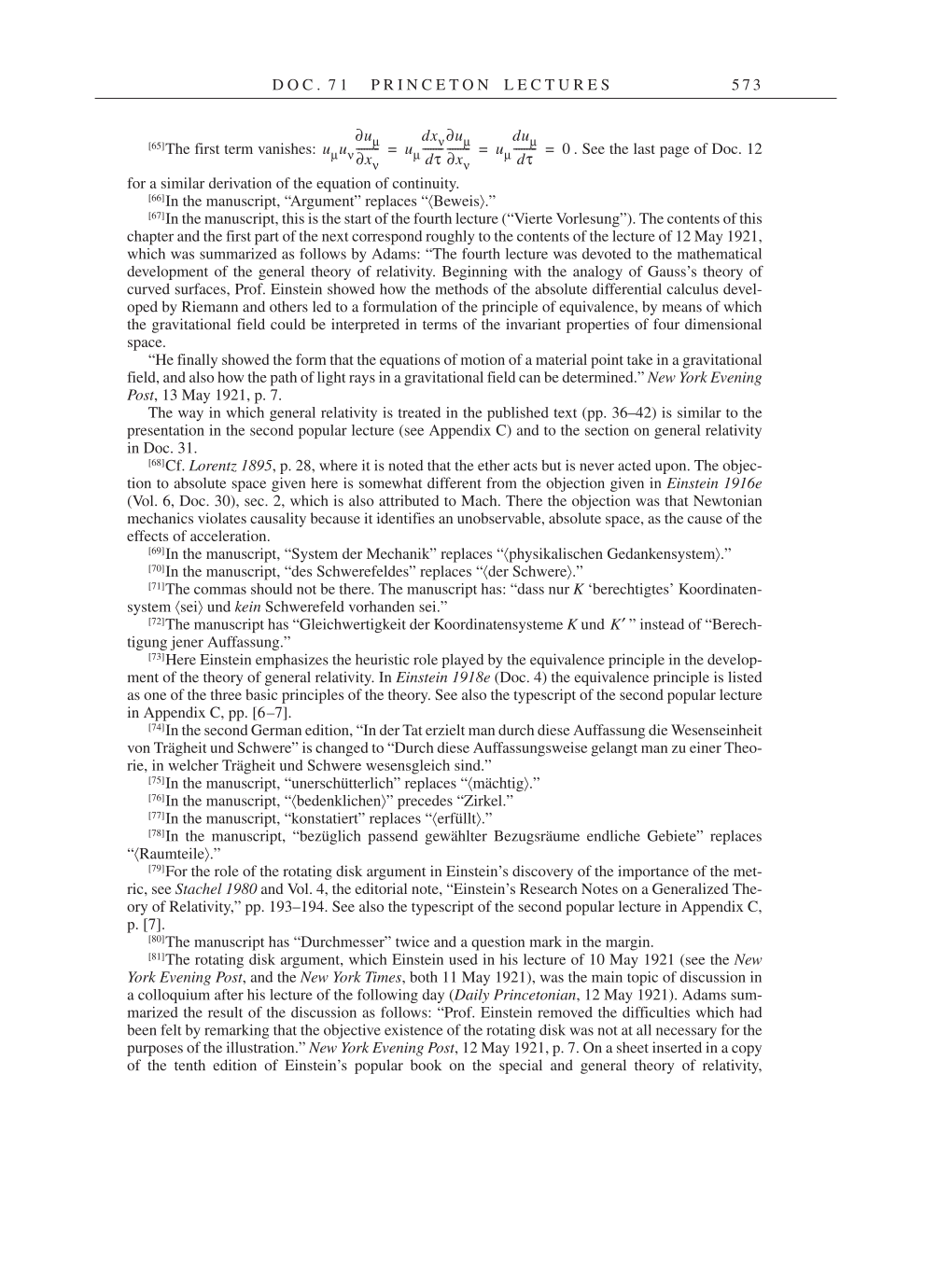D O C . 7 1 P R I N C E T O N L E C T U R E S 5 7 3
[65]The first term vanishes: . See the last page of Doc. 12
for a similar derivation of the equation of continuity.
[66]In the manuscript, “Argument” replaces “〈Beweis〉.”
[67]In the manuscript, this is the start of the fourth lecture (“Vierte Vorlesung”). The contents of this
chapter and the first part of the next correspond roughly to the contents of the lecture of 12 May 1921,
which was summarized as follows by Adams: “The fourth lecture was devoted to the mathematical
development of the general theory of relativity. Beginning with the analogy of Gauss’s theory of
curved surfaces, Prof. Einstein showed how the methods of the absolute differential calculus devel-
oped by Riemann and others led to a formulation of the principle of equivalence, by means of which
the gravitational field could be interpreted in terms of the invariant properties of four dimensional
space.
“He finally showed the form that the equations of motion of a material point take in a gravitational
field, and also how the path of light rays in a gravitational field can be determined.” New York Evening
Post, 13 May 1921, p. 7.
The way in which general relativity is treated in the published text (pp. 36–42) is similar to the
presentation in the second popular lecture (see Appendix C) and to the section on general relativity
in Doc. 31.
[68]Cf. Lorentz 1895, p. 28, where it is noted that the ether acts but is never acted upon. The objec-
tion to absolute space given here is somewhat different from the objection given in Einstein 1916e
(Vol. 6, Doc. 30), sec. 2, which is also attributed to Mach. There the objection was that Newtonian
mechanics violates causality because it identifies an unobservable, absolute space, as the cause of the
effects of acceleration.
[69]In the manuscript, “System der Mechanik” replaces “〈physikalischen Gedankensystem〉.”
[70]In the manuscript, “des Schwerefeldes” replaces “〈der Schwere〉.”
[71]The commas should not be there. The manuscript has: “dass nur K ‘berechtigtes’ Koordinaten-
system 〈sei〉 und kein Schwerefeld vorhanden sei.”
[72]The manuscript has “Gleichwertigkeit der Koordinatensysteme K und ” instead of “Berech-
tigung jener Auffassung.”
[73]Here Einstein emphasizes the heuristic role played by the equivalence principle in the develop-
ment of the theory of general relativity. In Einstein 1918e (Doc. 4) the equivalence principle is listed
as one of the three basic principles of the theory. See also the typescript of the second popular lecture
in Appendix C, pp. [6–7].
[74]In the second German edition, “In der Tat erzielt man durch diese Auffassung die Wesenseinheit
von Trägheit und Schwere” is changed to “Durch diese Auffassungsweise gelangt man zu einer Theo-
rie, in welcher Trägheit und Schwere wesensgleich sind.”
[75]In the manuscript, “unerschütterlich” replaces “〈mächtig〉.”
[76]In the manuscript, “〈bedenklichen〉” precedes “Zirkel.”
[77]In the manuscript, “konstatiert” replaces “〈erfüllt〉.”
[78]In the manuscript, “bezüglich passend gewählter Bezugsräume endliche Gebiete” replaces
“〈Raumteile〉.”
[79]For the role of the rotating disk argument in Einstein’s discovery of the importance of the met-
ric, see Stachel 1980 and Vol. 4, the editorial note, “Einstein’s Research Notes on a Generalized The-
ory of Relativity,” pp. 193–194. See also the typescript of the second popular lecture in Appendix C,
p. [7].
[80]The manuscript has “Durchmesser” twice and a question mark in the margin.
[81]The rotating disk argument, which Einstein used in his lecture of 10 May 1921 (see the New
York Evening Post, and the New York Times, both 11 May 1921), was the main topic of discussion in
a colloquium after his lecture of the following day (Daily Princetonian, 12 May 1921). Adams sum-
marized the result of the discussion as follows: “Prof. Einstein removed the difficulties which had
been felt by remarking that the objective existence of the rotating disk was not at all necessary for the
purposes of the illustration.” New York Evening Post, 12 May 1921, p. 7. On a sheet inserted in a copy
of the tenth edition of Einstein’s popular book on the special and general theory of relativity,
uμuν--------
∂uμ
∂xν
- uμ----------------
dxν∂uμ
dτ ∂xν
- uμ--------
duμ-
dτ
0 = = =
K′
